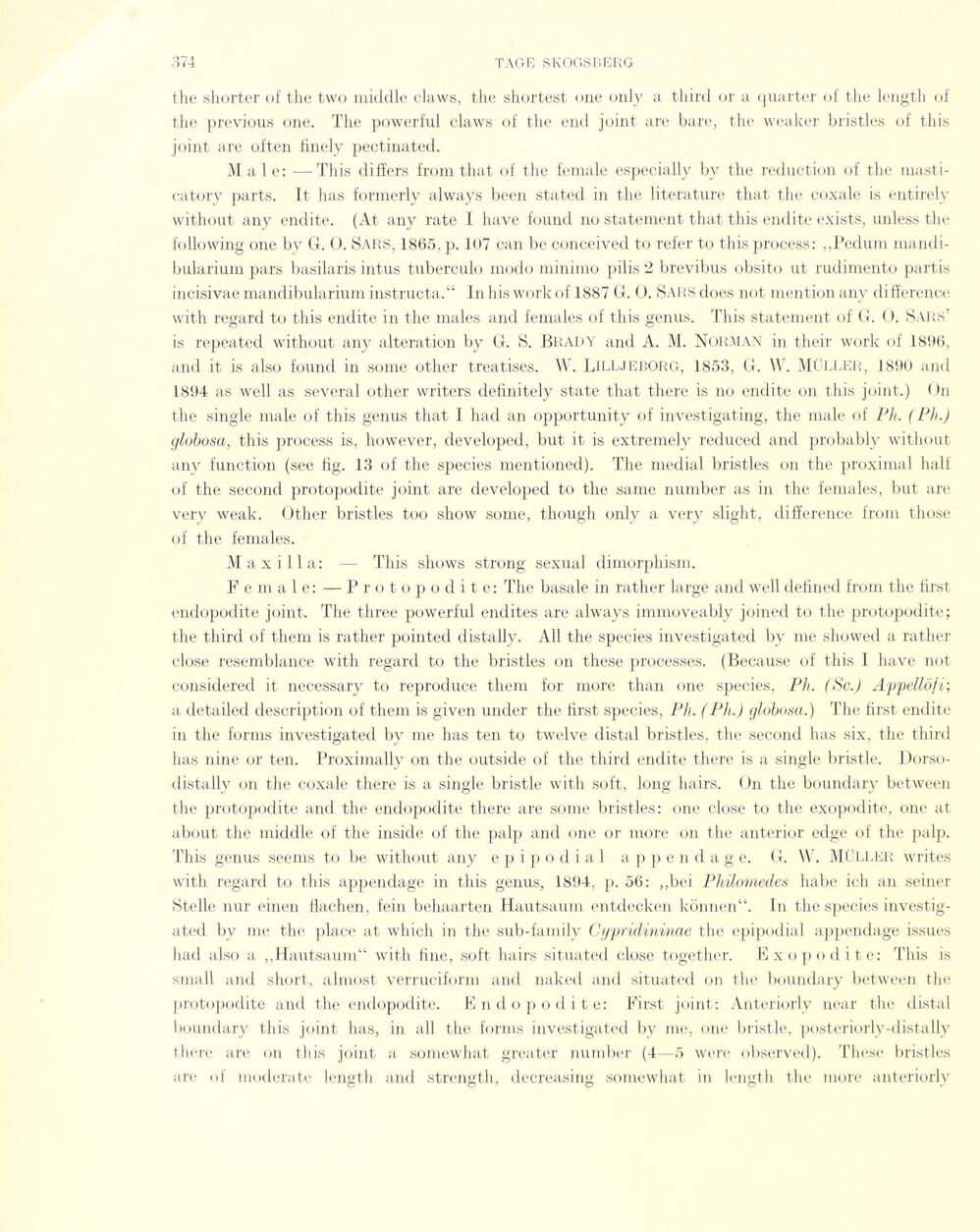
Full resolution (JPEG) - On this page / på denna sida - Sidor ...

<< prev. page << föreg. sida << >> nästa sida >> next page >>
Below is the raw OCR text
from the above scanned image.
Do you see an error? Proofread the page now!
Här nedan syns maskintolkade texten från faksimilbilden ovan.
Ser du något fel? Korrekturläs sidan nu!
This page has never been proofread. / Denna sida har aldrig korrekturlästs.
the skorter of the two middle claws, the shortest one only a third or a quarter of the length of
the previous one. The powerful claws of the end joint are bare, the weaker bristles of this
joint are often finely pectinated.
Male: ■—This differs from that of the female especially by the réduction of the
masti-catory parts. It has formerly always been stated in the literature that the coxale is entirely
without any endite. (At any rate I have found no statement that this endite exists, unless the
following one by G. O. Sars, 1865, p. 107 can be conceived to refer to this process: „Pedum
mandibularium pars basilaris intus tuberculo modo minimo pilis 2 brevibus obsito ut rudimento partis
incisivae mandibularium instructa.“ In his work of 1887 G. 0. Saks does not mention any difference
with regard to this endite in the males and females of this genus. This statement of G. 0. Sars’
is repeated without any alteration by G. S. BRADY and A. M. NORMAN in their work of 1896,
and it is also found in some other treatises. W. LilljebORG, 1853, G. W. MÜLLER, 1890 and
1894 as well as several other writers definitely state that there is no endite on this joint.) On
the single male of this genus that I had an opportunity of investigating, the male of Ph. ( Pli.)
globosa, this process is, however, developed, but it is extremely reduced and probably without
any function (see fig. 13 of the species mentioned). The medial bristles on the proximal half
of the second protopodite joint are developed to the saine number as in the females, but are
very weak. Other bristles too show some, though only a very slight, difference from those
of the females.
Maxilla: — This shows strong sexual dimorphism.
Fe male: — Protopo dite: The basale in rather large and well defined from the first
endopodite joint. The three powerful endites are always immoveably joined to the protopodite;
the third of them is rather pointed distally. All the species investigated by me showed a rather
close resemblance with regard to the bristles on these processes. (Because of this I have not
considérée! it necessary to reproduce them for more than one species, Ph. (Sc.) Appellofi;
a detailed description of them is given under the first species, Ph. (Ph.) globosa.) The first endite
in the forms investigated by me has ten to twelve distal bristles, the second has six, the third
has nine or ten. Proximally on the outside of the third endite there is a single bristle.
Dorso-distally on the coxale there is a single bristle with soft, long hairs. On the boundary between
the protopodite and the endopodite there are some bristles: one close to the exopodite, one at
about the middle of the inside of the palp and one or more on the anterior edge of the palp.
This genus seems to be without any e p i p o d i a 1 appendage. G. W. MÜLLER writes
with regard to this appendage in this genus, 1894, p. 56: „bei Philomedes habe ich an seiner
Stelle nur einen flachen, fein behaarten Hautsaum entdecken können“. In the species
investigated by me the place at which in the sub-family Cypridininae the epipodial appendage issues
had also a „Hautsaum“ with fine, soft hairs situated close together. Exopodite: This is
small and short, almost verruciform and naked and situated on the boundary between the
protopodite and the endopodite. Endopodite: First joint: Anteriorly near the distal
boundary this joint has, in all the forms investigated by me, one bristle, posteriorly-distally
there are on this joint a somewhat greater number (4—5 were observed). These bristles
are of moderate length and strength, decreasing somewhat in length the more anteriorly
<< prev. page << föreg. sida << >> nästa sida >> next page >>